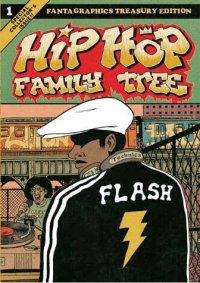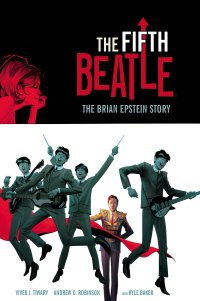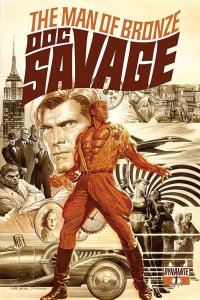Hip Hop Family Tree #1 (Fantagraphics, $24.99)
by Graig Kent
I was of the first generation to grow up with hip-hop as a commercial entity, with Run DMC, DJ Jazzy Jeff and the Fresh Prince, LL Cool J and the Fat Boys intermingling with Madonna, Tears For Fears and Katrina and the Waves on top 40 radio. But there was a whole generation before that which wasn’t mainstream, that didn’t get the same exposure that the next wave of DJs and emcees would find. It’s not that they weren’t successful, just that they were niche at the time. A fad some would call them, where others could see a groundswell just waiting to rise. These were the progenitors of hip-hop, the originators of the scene, the creators, the innovators, the waxmen and mouthpieces, the hype men and the promoters, the businessmen and the scenesters that made rap a phenomenon that has yet to relinquish its thrall on each new generation, despite (or perhaps because of) the numerous evolutions it goes through.
When I would listen to mid/late-1980’s rap music, I would hear the names dropped: DJ Kool Herc, Grandmaster Flash and Melle Mel, Kool DJ Red Alert, Afrika Bambaataa and more, but I never knew them as anything more than shoutouts. As rap grew and evolved, into consciousness hip-hop and West-coast gangsta, the name checking tended more towards peers than to forefathers, but within the music itself, unbeknownst to a kid like me who wasn’t exposed to the late-70’s/early 80’s Bronx scene, the music, the lyrics, the sampling, scatting and beatboxing all routinely pointed back at the past with respect and admiration.
With this in mind, reading Ed Piskor’s Hip Hop Family Tree is like finally seeing the picture to a puzzle you didn’t even know you were working on. In an oversized treasury edition, Piskor dives headlong into hip-hops all too underserviced past, hovering heavily around the Bronx party scene as Kool Herc discovers breaks and scratching becomes a thing. And that’s just the first page. Beyond that, Piskor explores how hip-hop took over a substitute for gang culture, and how that cultural shift manifested itself the heavy bravado and self-aggrandizing that still permeates the culture, from crew rivalries that seemed to exist from day one to the invention of rap battles. So much of the culture that’s only really hit the consciousness of the mainstream has been a part of it since almost the beginning.
Piskor’s story here is a linear one, but it’s not a simply told or straightforward one. There’s a great number of influential artists and personalities who played their part in making hip hop and DJing more than just a local trend, and Piskor takes great pains to include even the most minor of contributions. It does lead to a bit of disjointedness, also probably not helped by the web-serial origins of the book, but at the same time the sheer volume of information and the depth of detail Piskor more than makes up for any lack of narrative cohesion.
Beyond that, Piskor’s art is terrific, with a bit of a cartoonist’s exaggerated edge, he draws every personality uniquely and identifiably distinct, surrounded by a rich world of late-’70’s/early-’80’s detail. He’s not just dealing with rappers, but whole sections of New York city, landmarks both inside and outside, crowded and at times hostile. He gets into the influence of the art scene, Fab Five Freddy and Jean Michael Basquiat, and how that brought another visual component to the culture. There’s art galleries and studio recordings, record shops and Soul Train, trips to Europe and subway rides. Through all the scene changes, Piskor excels at dramatizing how hip hop starts permeating the consciousness, with radios in backgrounds playing songs, or conversations occurring around future players, or the dramatic wardrobe shifting. It’s all incredibly fascinating to behold.
The most impressive feat of Hip Hop Family Tree, beyond the exposure to a piece of history that doesn’t get talked about enough, is how Piskor has made a music documentary essentially without the music. But the strength of rap is in the words… the DJs play an important part, but it’s what can be said and how it is said that is key to the genre. Lyrics and rhymes are an integral part of rap, and Piskor constantly informs us of what each personality is perhaps best known for, be it a popular vocal sample used across the decades or a particular flavour of scatting or an important flow that started changing the game from party anthems to something more meaningful.
It’s an incredibly engaging read, I’d surmise even more so if you know even a few of the references, but it’s still not essential to have a lot of rap in your background. A discography in the backmatter is certainly helpful (indispensable even) if, like me, you’re not all that familiar with the works of Kurtis Blow or you’ve never heard hip-hops influence on Blondie (“The Rapture”). It’s a decidedly interesting examination of the birth and growth of a culture. It’s one which Piskor is continuing on boingboing , where it was originally published as a serial, which is great news because it means we’re definitely due for another volume.
Rating: 




Out of a Possible 5 Stars
 The Fifth Beatle: The Brian Epstein Story (Dark Horse, $19.99)
The Fifth Beatle: The Brian Epstein Story (Dark Horse, $19.99)
By Jeb D.
It’s been interesting to read the advance buzz and early reviews on this title, with an eye to the modern perspective: writer Vivek Tiwary, as well as most of today’s readers and reviewers, are viewing the life of Beatles manager Brian Epstein as something of a historical curiosity in need of rediscovery.
But as one who lived through Beatlemania, I can tell you that Epstein was hardly an obscure figure in those days: the dapper Englishman was certainly less omnipresent than his charges, but he was well-enough known to the general public, so much so that he was impersonated and parodied in pop culture (among other things, The Flintstones featured a music impresario named “Eppy Brianstone,” something that the managers of, say, Frank Sinatra or Elizabeth Taylor or Mickey Mantle never achieved). That might be why parts of Tiwary’s script feel a tad choppy: knowing the general outline of Epstein’s story, some of the omissions are a bit puzzling (his being forced by the Beatles to be the one to tell Pete Best he was out of the band being the most obvious), and while, in his afterword, Tiwary reminds us that any biographer has to pick and choose among the happenings of his subject’s life, there’s no guarantee that every choice will be the right one (among other things, the jump-cut from Ed Sullivan introducing the band’s first appearance to a single splash page of the insane year of 1964 compresses a lot of fascinating history). He also goes rather easily on the Beatles themselves: their portrayal here is pretty much summed up by the cheekiness of the four lads from A Hard Day’s Night—and while there’s obviously a level of truth to those characterizations, I’d have liked to see Tiwary dig more deeply into the relationship between Epstein and his charges, who could be inconsiderate, and downright cruel, to their hard-working, indefatigable manager.
Now, with those niggling critiques out of the way, let’s move right along into consideration of what is probably the best graphic novel I’ve read all year. Regardless of its brief to re-introduce Epstein to today’s readers, and its “Swinging 60’s” setting, its portrait of the young English entrepreneur has a powerful timelessness. Gay in a time and place where to declare yourself such was an invitation to jail and ruin, Epstein stands in for the outsider, as valid a choice today as it was a half-century ago, while never being less than unique as a person.
Epstein’s relentless belief in the seeming impossible—that the scruffy young Liverpool musicians would be “bigger than Elvis”—fails him in every area save that of the Fab Four themselves. The support of his family (whose music retailing business has given him the industry entrée that allows him to believe he can manage a pop group) can’t keep him from worrying that he’s letting them down, as the Beatles are rejected over and over again by record labels who are less than impressed by the credentials of the young music-store scion. Even at the height of the Beatles’ success, Epstein is despondent that his inexperience has cost the band millions of pounds of merchandising opportunities, and before long, his occasional pill-popping becomes a full-blown dependency. And his blithe expectation that romantic love can be the province of two men ranges from fantasy to cruel deception. As I indicated above, I do think Tiwary goes a bit easy on John Lennon, and the reader, in this respect: Beatle historians are divided on the question of whether Lennon nastily rejected Epstein’s hesitant sexual interest, or succumbed in a bout of self-loathing, but the casual wink and shrug that the incident gets here feels as though Tiwary’s treading lightly for the sake of not losing the twinkle in Lennon’s eye.
None of this is news to anyone familiar with the general outlines of the Beatles/Epstein story, but it’s rarely, if ever, been portrayed with the kind of insight that Tiwary provides. And even if it’s not “new,” the degree to which his sexual tendencies defined and depressed Epstein has only been allowed to come out (so to speak) in recent years. With that freedom, Tiwary brings Epstein as completely to life as any character, real or fictional, that I’ve read in any medium this year. Even the slightly surreal/supernatural elements that emerge in the sad, slow drift into Epstein’s final moments (like something out of the final scenes of Kubrick’s 2001) feel of a piece with the man we’ve come to know over the preceding 100 or so pages.
When we talk about comic art as “cinematic,” we often think about the aggressive, action-movie pencils of a Frank Miller or Howard Chaykin, or the experiementation of Will Eisner or Bernard Krigstein; painted comics more often seem to go in for a more static, “illustrative” approach. But artist Andrew C. Robinson drives The Fifth Beatle along propulsively: his Liverpool is gorgeously gloomy, his Swingin’ London vivid, but it’s his eye for using just the right shot at just the right time that sticks with you: it’s not easy to put your finger on, but his choice to go, say, from wide shot to close-up invariably feels like the only choice available for the situation, moving your eye effortlessly from page to page. And even when you have such famous faces to work with, it’s no mean feat to keep the facial features and anatomic details so consistent. Maybe what’s most impressive is how simple he makes it look: most of the paneling is fairly linear and conventional, and there are few showy flourishes, but the visuals are always compelling. And even where Tiwary has given him some obvious visual metaphors (Epstein’s love of bullfighting, the set of shark’s teeth he assigns to the grotesque Colonel Tom Parker), Robinson keeps the visuals arresting: it’s not unusual for comic art to sacrifice storytelling for beauty, or vice versa; The Fifth Beatle is one of those rare books that unerringly hits the mark on both qualities. And to vary things just a bit, a couple of segments (including the bizarre black-comic events of the Beatles’ 1966 Phillipines visit) are illustrated by Kyle Baker, bringing a level of wit and absurdity that evokes the crudity of a John Lennon drawing.
In a way, The Fifth Beatle reminds me of Fraction and Zdarsky’s Sex Criminals: a story that would, on its own, be as readable and well constructed as any biography I’ve read recently, is elevated even higher by artwork that compels re-reading, and a reminder of the unique virtues of graphic storytelling.
Rating: 




Out of a Possible 5 Stars
Doc Savage #1 ($3.99, Dynamite)
by D.S. Randlett (@dsrandlett)
I feel like I’ve had to trot out and summarily execute various blind spots in my geekery since joining the TCC gang. Part of this has been voluntary, while at other time it’s been for lack of truly interesting new first issues to seek out and review. I’d say that it was a combination of those two factors that lead me to picking up the latest iteration of the venerable Doc Savage, with a slight edge given to my desire to get in on something that might provide an easy means of beginning a new chapter in my geek education. I have known of the character’s legacy for certain, and the Doc Savage analog Axel Brass from Warren Ellis’ Planetary was always a welcome presence. So, I’d assume that I’m the target audience here, but does Doc Savage invite the new fan?
In the barest sense, I suppose that it does. This first issue presents the first chapter of what appears to be the origin story of Doc Savage and, to some extent, his eclectic posse. This isn’t their first adventure by any means, but Doc sure as hell doesn’t quite look like the hardened man on the cover. Here, he’s more academic than adventurer, going far afield in search of new knowledge rather than crusading for justice. In terms of quality, it’s entirely another matter. In terms of entry points, I guess Doc Savage ticks the requisite boxes, but it does nothing to entice, which is surprising as it comes from Chris Roberson, the writer of the rather fun Edison Rex. Here Roberson makes some stylistic choices that are perfectly logical, like the period appropriate narration, but they almost never get off the ground. I realize that series like this, that trade on very old reputations, need to have a certain feel, but there is very little of the author here. Add to that a mystery/adventure that, on its own terms, just is not compelling, and the result is boredom.
Which is a shame, as the art by Bilquis Evely is actually pretty good, and does a really good job of capturing the feel of its era and setting. But in the service of an adventure so rote and pedestrian, there’s just very little for Evely to actually do.
I really wanted to like Doc Savage and be able to recommend it as a fine adventure series, but as it stands I can only recommend it as a soporific. Man of Bronzzzzz.
Rating: 




Out of a Possible 5 Stars